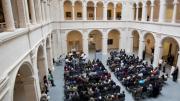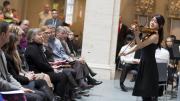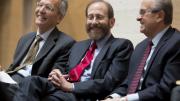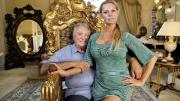Sitting in the Calderwood Courtyard this past Sunday, beneath a luminous glass roof designed by Renzo Piano, members of the Harvard community and Cambridge residents officially inaugurated the newly renovated Harvard Art Museums. “It has been a fundamental rethinking of what a university art museum should be for the twenty-first century,” said Cabot director of the Harvard Art Museums Thomas W. Lentz in opening the morning program. “With this transformation, three extraordinary museums”—the Fogg, the Busch-Reisinger, and the Sackler—“and their collections are joined together for the first time in one location under one beautiful roof. We are now more open, more transparent, and accessible—what was once largely hidden is now revealed. ”
Lentz discussed the decade of hard work and re-creation that went into the renovation that united the museums. Collections, he said, will be used in new and different ways, with an emphasis on art conservation as well as visibility. In particular, he pointed out that the art study center located on the fourth floor will be a place for students and faculty to explore objects on a deeper level for longer periods of time—because ultimately, the museums are an academic institution, designed to create new teaching and learning experiences. “We are not a static treasure house—we are not a closed academic bunker,” he said. “We want to break down the barrier between these three great museums and create visual, historical links that have never existed before. With this new building we have now unleashed the vast potential of these collections.”
With a nod to Harvard’s history of honoring art, poetry, and music, several students were among those invited to perform during the opening event. Williams professor of urban planning and design Jerold S. Kayden composed an original musical work for the opening, appropriately titled Inauguration Theme and Fanfare, played by the brass quintet and percussion ensemble from the New England Conservatory of Music. Other performers included graduate student David Nee, who read Tomas Tranströmer’s poem “Vermeer,” and violinist Sumire Hirotsuru ’16, who delivered a rendition of a Bach partita.
Provost Alan Garber recalled his days as a Harvard student living on Prescott Street, not far from the entrance of the Fogg Museum; at the time, he said, the building was not that inviting because only its backside was visible. Today, he continued, the museums’ entrances are not only visible, but impossible to miss—a feat that will surely create a crossroads for Harvard and the surrounding Cambridge community. Art, he pointed out, is central to the intellectual life of the University, and the renovated museums will provide “a treasure to the world in our own backyard.”
Cambridge city manager Richard C. Rossi remembered visiting the museums prior to their renovation and feeling that they were impressive, but also seemed “a little aged.” Walking into the new space, he said, he felt “amazed,” and offered official congratulations from the City of Cambridge.
“I think [this building] is a tribute to Harvard and the way it thinks about its students and its family,” he said, adding that he is impressed by the work the University has done to make the facility accessible to the Cambridge community. “It’s an incredible presence, and everyone will be able to see one of the great museums in this world.”
Watch Sumire Hirotsuru ’16 perform a rendition of a Bach partita:










